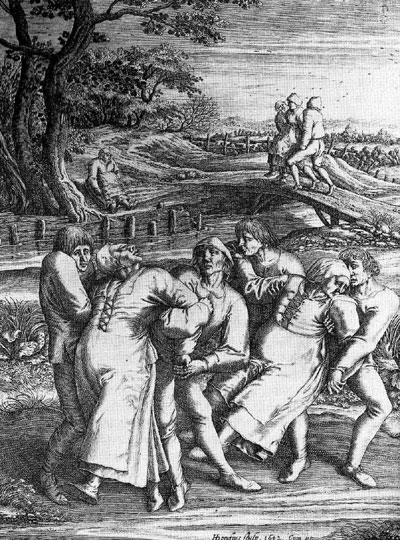 |
| Depiction of the dancing mania |
One of the first and largest outbreaks of dancing mania was reported in July of 1374 in Aachen, Germany. This outbreak of dancing mania spread as far as France and lasted for several years. Another famous outbreak was known as “The Dancing Plague of 1518.” It occurred in Strasbourg, France and affected an estimated 400 people. Dancing mania still occurs to this day. However, it comes in various forms and typically not in the same fashion as it once did. For example, it sometimes occurs during religious ceremonies and does not spread to the outside population.
The cause of dancing mania is unknown. However, there are several theories that seem likely. The first of these is mass hysteria. This is the likeliest explanation for dancing mania that occurs during religious events. Another possible explanation is known as mass psychogenic illness, which is a form of mass hysteria. Mass psychogenic illness occurs when groups of people mistakenly believe that are afflicted with a common illness. Victims may convincingly display symptoms of said illness.
The spread of dancing mania during the medieval period in Europe may not be so easily explained, even though people may have been more susceptible to mass hysteria given the living conditions of the period and location. There is another explanation that may be more likely, however. It is known as ergotism or ergot poisoning. Ergotism is contracted from a fungus that is able to grow on many grains, such as corn and rye. The symptoms of ergotism are very similar to those of dancing mania. It is possible that this fungus infected food supplies of the afflicted areas.
Scientists may never be able to figure out exactly what caused the dancing mania outbreaks in medieval Europe. However, they may be able to come up with more conclusive theories through the study of modern outbreaks. Then again, modern outbreaks may have different causes. This disease, hysteria or whatever it is, is quite as strange as the symptoms it produces.
Sources
10 Weird Science Facts You Didn’t Know, 11/8/06, retrieved 2/3/10, odee.com/item_63950.aspx
O’Neill, David, Etiology of the Dancing Plague, retrieved 2/3/10, iph.fsu.edu/interculture/pdfs/oneill dancing plague.pdf
No comments:
Post a Comment